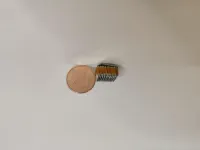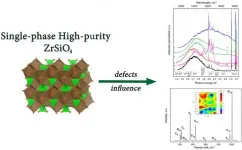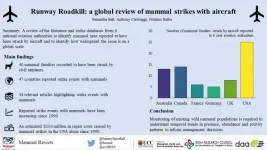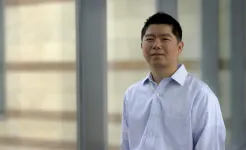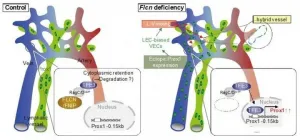(Press-News.org) Researchers from the Department of Infection and Immunity of the Luxembourg Institute of Health (LIH) brought forward the potential of high doses of a specific adjuvant molecule, namely CpG oligonucleotide, in successfully modulating the immune system's allergic response to the main cat allergen Fel d 1, thereby inducing a tolerance-promoting reaction and reverting the main hallmarks of cat allergy. The researchers analysed the molecular mechanisms underlying this tolerance and proposed a pre-clinical allergen-specific immunotherapy approach to improve the treatment and control of this common type of allergy. The full study results were published recently in the renowned international journal Allergy, the official journal of the European Academy of Allergy and Clinical Immunology (EAACI) and one of the top two journals worldwide in the allergy field.
Cat allergy is a rapidly increasing phenomenon characterised by an hypersensitivity and excessive immune response to certain allergens associated with felines, particularly Fel d 1, a protein typically found in their saliva, glands, skin and fur. Cat allergy manifestations can range from mild symptoms to the development of severe conditions such as rhinitis and asthma, with potentially fatal outcomes. While pharmacotherapy is an option for the milder forms, only allergen-specific immunotherapy (AIT) can ensure an effective and longer lasting treatment in the more advanced cases. AIT typically consists in the subcutaneous injection of gradually increasing quantities of the allergen in question, until a critical dose is reached that induces long-term immune tolerance. Nevertheless, there is still the need to improve cat AIT in terms of efficacy and safety. The researchers hypothesised that the most effective cat AIT could be achieved by optimising the response of immune system T- and B-cells through immune adjuvants to induce the production of antibodies against Fel d 1 while minimising inflammatory reactions, thereby boosting immune tolerance to this allergen.
"We sought to explore new means of increasing the anti-inflammatory activity of AIT with the known immunomodulatory adjuvant CpG, but at a higher safe dose than previously used for this type of therapy", explains Dr Cathy Léonard, scientist within the Allergy and Clinical Immunology research group at the LIH Department of Infection and Immunity and co-corresponding first author of the publication.
To study the cellular and clinical effects of an AIT based on the injection of the Fel d 1 allergen in combination with a high dose of CpG adjuvant, the team challenged Fel d 1-allergic mice with the allergen, both in the presence and absence of AIT. The scientists observed that AIT-treated allergic mice showed a significantly improved lung resistance, similar to that of non-allergic control mice, when compared with untreated allergic mice, with signs of airway inflammation and hyper-responsiveness being considerably reduced. Indeed, when looking at the Fel d 1-specific antibodies, the team noticed that AIT-treated allergic mice displayed lower levels of IgE, which are commonly associated with allergic responses, and higher levels of IgA and IgG, which can have anti-inflammatory properties. In addition, AIT-treated allergic mice showed a reduction in the levels of certain pro-allergic cytokine molecules, produced by type 2 helper T cells (Th2), compared to untreated allergic animals. The researchers also noticed that, already very soon after AIT-injection, there was an increase in the tissues of AIT-treated mice in the abundance of immune cell types involved in allergy regulation and tolerance, namely plasmacytoid dendritic cells (pDCs), Natural Killer cells (NKs), regulatory T cells (T-regs) and regulatory B cells (B-regs). These cells were found to express higher levels of the Tumour Necrosis Factor alpha (TNF-α) receptor 2 (TNFR-2), with NK cells also producing the TNF-α cytokine, which are known to play a role in suppressing the allergen-specific immune response, thereby allowing these regulatory cells to act as a 'brake' on the immune system. "At a later stage, we observed a clear increase of TNF-α in the lungs. Interestingly, AIT also triggered the appearance of a novel and unique type of Tregs, known as biTregs, which is even better equipped to counterbalance the allergic and inflammatory reaction in response to the antigen", adds Dr Léonard. Collectively, these findings point towards the strong anti-inflammatory and anti-allergic effect induced by AIT with a high and safe dose of CpG adjuvant. Quite strikingly, however, the researchers found that the mechanism underlying this allergy-protective action varies according to whether the treatment is administered as a vaccine to mice that had never previously been exposed to the Fel d 1 antigen, and which therefore did not present an existing allergic state, or under already established allergic conditions, as is the case in AIT. The elucidation of these alternative pathways opens up new insights for the future design of preventive and curative allergy vaccines using CpG adjuvant.
Going further in the translation of these findings into applications for the pre-clinical setting, the scientists developed a delivery system based on the subcutaneous injection of the Fel d 1/CpG treatment, as opposed to the more invasive intraperitoneal administration route. The results equally demonstrated the reversal of all allergy hallmarks and confirmed the anti-allergic effects of the AIT.
"In essence, we propose a pre-clinical model of AIT for cat allergy, which mimics the conditions required for human AIT clinical trials and which is already optimised for future use in translational studies. Indeed, our study presents several novelties including the use of endotoxin-free Fel d 1 allergen, which is mandatory in the clinical setting, to prevent the onset of collateral inflammatory responses which could compromise the desired induction of the tolerance-promoting mechanisms. Moreover, we show for the first time that the use of the maximum dose of CpG tolerated in humans has the ability to modulate the allergic response when combined with Fel d 1 allergen, with very favourable safety profiles and through a well-established and medically-approved delivery mode. Based on our data, we believe that CpG deserves reconsideration as an effective AIT adjuvant in humans and that our work sets the bases for the development of novel successful immunotherapeutic treatments for allergies", concludes Prof Markus Ollert, Director of the LIH Department of Infection and Immunity and senior lead author of the study.
INFORMATION:
The findings were published in the international journal Allergy, with the full title "Comprehensive mapping of immune tolerance yields a regulatory TNF receptor 2 signature in a murine model of successful Fel d 1-specific immunotherapy using high-dose CpG adjuvant".
Funding and collaborations
This study was supported by grants from the Luxembourg National Research Fund (FNR) under the PRIDE programme (PRIDE/11012546/NEXTIMMUNE).
It was performed in close collaboration with national and international partners, and involved LIH's Department of Infection and Immunity (DII), the National Cytometry Platform of LIH's Quantitative Biology Unit, Dr Hentges of the National Unit of Immunology-Allergology of the Centre Hospitalier de Luxembourg (CHL), the Department of Clinical Research of the University of Southern Denmark (Denmark), the Center of Allergy and Environment (ZAUM) of the Technical University of Munich and Helmholtz Center Munich (Germany) and the Department of Dermatology and Allergy of the Odense Research Center for Anaphylaxis (ORCA) at the University of Southern Denmark (Denmark).
Sudden cardiac arrest is more often fatal in people with COVID-19, a new study shows. Those responsible for the research see the results as a wake-up call for the public and care providers alike.
The survey now published in the
European Heart Journal is a register-based observation study. It covers all 3,026 cases of sudden cardiac arrest that were reported to the Swedish Registry for Cardiopulmonary Resuscitation in the period from 1 January to 20 July 2020 -- that is, both before and during the pandemic.
The Registry's statistics show that, in Sweden, there are 6,000 cases of sudden cardiac ...
Ozone is a problematic air pollutant that causes serious health problems. A newly developed material not only quickly and selectively indicates the presence of ozone, but also simultaneously renders the gas harmless. As reported by Chinese researchers in Angewandte Chemie, the porous "2-in-one systems" also function reliably in very humid air.
Ozone (O(3)) can cause health problems, such as difficulty breathing, lung damage, and asthma attacks. Relevant occupational safety regulations therefore limit the concentrations of ozone allowable in the workplace. Previous methods for the detection of ozone, such as those based on semiconductors, have a variety ...
Thermoelectric generators, TEGs for short, convert ambient heat into electrical power. They enable maintenance-free, environmentally friendly, and autonomous power supply of the continuously growing number of sensors and devices for the Internet of Things (IoT) and recovery of waste heat. Scientists of Karlsruhe Institute of Technology (KIT) have now developed three-dimensional component architectures based on novel, printable thermoelectric materials. This might be a milestone on the way towards use of inexpensive TEGs. The results are reported in npj Flexible Electronics (DOI: 10.1038/s41528-020-00098-1) and ACS Energy Letters (DOI: 10.1021/acsenergylett.0c02159).
"Thermoelectric generators directly convert thermal into electrical energy. This technology enables ...
The scientific novelty of the work of scientists from Ural Federal University, Institute of Solid State Chemistry and Geology and Geochemistry of the Ural Branch of the Russian Academy of Sciences lies in the fact that for the first time scientists solved the task of creating zircon with certain spectral properties. To this end, they have worked out the so-called sol-gel method.
It is distinguished by its technological simplicity, controllability of processes and allows synthesizing a larger volume of products with high purity than with other ...
Using patient data, artificial intelligence can make a 90 percent accurate assessment of whether a person will die from COVID-19 or not, according to new research at the University of Copenhagen. Body mass index (BMI), gender and high blood pressure are among the most heavily weighted factors. The research can be used to predict the number of patients in hospitals, who will need a respirator and determine who ought to be first in line for a vaccination.
Artificial intelligence is able to predict who is most likely to die from the coronavirus. In doing so, it can also help decide who should be at the front of the line for the precious vaccines now being administered across Denmark.
The result is from a newly published study by researchers at the University of Copenhagen's Department ...
- World's wildlife, from giraffes to voles, kangaroos to coyotes being hit by aircraft.
- Study identifies incidences at airports in 47 countries across the globe.
- 'Runway Roadkill' increasing by up to 68% annually and has caused damage that has cost in excess of $103 million in the United States alone over a 30 year period.
- It is hoped study could pave way for international efforts to protect wildlife and reduce costly aircraft damage.
From giraffes to the world's smallest mammals, the world's wildlife is being increasingly struck by aircraft, a global study finds.
Airports from Sydney to London and the USA to Germany were examined by researchers who ...
LEBANON, NH - Dartmouth's and Dartmouth-Hitchcock's Norris Cotton Cancer Center (NCCC) is the first cancer center in the world to install BeamSite Cherenkov imaging cameras in its radiotherapy treatment rooms. The camera system, invented, validated and commercialized by entrepreneurs from NCCC and Dartmouth spinoff biomed tech company, DoseOptics, LLC, captures imaging and real-time video of the beam directly on the patient, allowing the radiation oncology team to visualize treatment delivery.
Cherenkov imaging makes radiation treatment a visual process. The Cherenkov effect occurs when photon or electron radiation beams interact with tissue, such as skin, producing a small light ...
University of Texas at Arlington researchers have developed a technique that programs 2D materials to transform into complex 3D shapes.
The goal of the work is to create synthetic materials that can mimic how living organisms expand and contract soft tissues and thus achieve complex 3D movements and functions. Programming thin sheets, or 2D materials, to morph into 3D shapes can enable new technologies for soft robotics, deployable systems, and biomimetic manufacturing, which produces synthetic products that mimic biological processes.
Kyungsuk Yum, an associate professor in the Materials ...
URBANA, Ill. ¬- Mealtimes are a central aspect of family life, affecting the health and wellbeing of both children and adults. Although the benefits of healthy mealtimes are straightforward, helping all families realize those benefits is quite complicated, new research from University of Illinois shows.
The study highlights ways in which some solutions - such as an exclusive focus on improving food access or on improving mealtime preparation and organization skills - may be less effective if done in isolation, says Allen Barton, assistant professor in the Department of Human Development and Family Studies at ...
Researchers from Kumamoto University (Japan) have clarified the mechanism by which blood and lymph vessels remain segregated from one another after development. The characteristics and structures of these two vessel types are very similar, and how they maintain separation has remained unexplained for many years. In this study, researchers found that the molecule Folliculin (FLCN) in vascular endothelial cells acts as a gatekeeper to maintain that separation.
Blood and lymphatic vessels form independent networks until the final confluence at the left and right venous angles in the neck. Blood vessels act as a pipeline that ...


